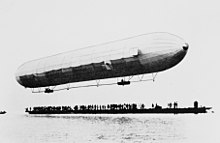LZ 1

The Zeppelin LZ 1 (LZ for "Airship Zeppelin") was Count Zeppelin's first airship .
history
LZ 1 was built in 1899 in a floating hall on Lake Constance in the Bay of Manzell, financed by the “Society for the Promotion of Airship Travel” founded in 1898 by Count Zeppelin. The airship was a rigid airship made of a skeleton covered with canvas. The canvas was made durable and weatherproof with cellulose varnish. The two Daimler engines drove four propellers in pairs. A driver's gondola at the front and a passenger gondola at the rear were connected by an open walkway, under which a 130 kg lead weight was movably attached to a rail to trim the aircraft. The first start was on July 2, 1900. Around 6 p.m. LZ 1 was maneuvered out of the assembly hall on the raft on which the airship was resting. About 12,000 spectators followed the action on the lake shore and on boats and small steamers.
At 8:03 p.m. the airship rose to the cheering of the crowd. Due to the breakage of a crank on the winch for moving the lead weight, the trim failed and LZ 1 had to make an emergency landing at Immenstaad after 18 minutes , with the airship leaking a fishing net post . The company's own tugboat pulled LZ 1 back to the hall during the night.
During the repair work, during which the barrel weight was moved inside the ship, a strong storm arose, which shook the hall so hard that several support rings in the hull broke. After all repairs had been completed, LZ 1 was pulled out of the hall by the tugboat on October 17, 1900 and went on its second voyage. After 80 minutes, the engines failed because a gasoline tank was accidentally filled with water. The airship had to make emergency water again and was pulled back to the hall by the tug.
On October 20, LZ 1 took off again, but after a 23-minute drive with its engines could not withstand the sudden strong winds and had to land. During this voyage, the Zeppelin had reached a speed of 9 m / s and thus exceeded the French airship La France by 3 m / s.
Due to the leakage of the cells, the high consumption of the expensive hydrogen gas proved to be a disadvantage . The aim was to sell Zeppelin airships for commercial and / or military purposes. For this, LZ 1 rose again on October 24, 1900 from Lake Constance in front of a prominent audience such as the King of Württemberg and his appraisers. The airship reached a speed of 8 m / s, but the report of the inspector of the transport troops turned out to be unfavorable: "LZ 1 is only to be regarded as a valuable test piece and is currently not usable for military purposes."
End of LZ 1
Since neither an airship could be sold nor new investors could be found and the shareholders of the Society for the Promotion of Aviation refused to provide further financing, it was decided to dissolve the company. Graf Zeppelin had to lay off most of his employees, dismantle the airship hangar for the repayment of the money from the signatories of the guarantee fund, scrap LZ 1 and sell everything as scrap.
Technical specifications
- Carrying gas volume: 11,300 m³ hydrogen
- Length: 128 m
- Diameter: 11.65 m
- Payload: 300 kg
- Drive: two four-cylinder Daimler engines, each with 14.2 hp (10 kW)
- Speed: 9 m / s (32.4 km / h)
literature
- Peter Meyer: Airships - The History of the German Zeppelins , Wehr & Wissen, Koblenz / Bonn 1980.


